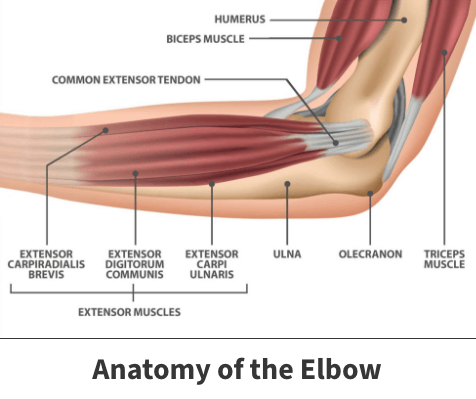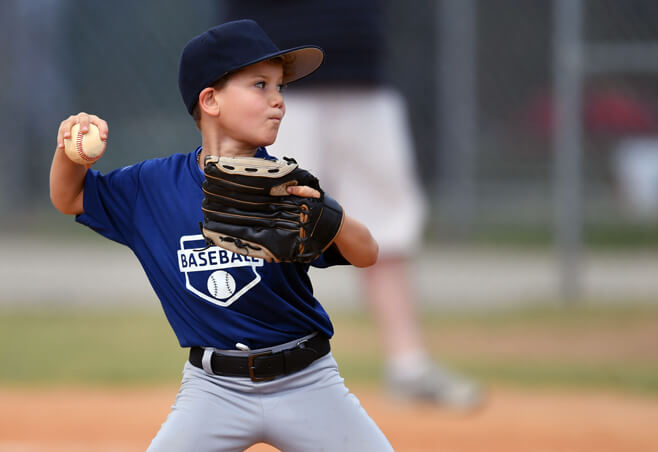Little leaguer's elbow
Medial apophysitis
With the start of the baseball season each spring, doctors frequently see an increase in elbow problems in young baseball and softball players. A common elbow problem in these children is Little Leaguer’s Elbow (Medial Apophysitis). This injury occurs when repetitive throwing creates an excessively strong pull on the tendons and ligaments of the elbow. Fortunately, treatment for this condition is done predominately through rest, unless it is severe. If severe, then your child may need surgery.
Anatomy

Your elbow joint is a joint made up of three bones: your upper arm bone (humerus) and the two bones in your forearm (radius and ulna). Muscles, ligaments, and tendons hold the elbow joint together.
The elbow is both a hinge and a pivot joint. The hinge part of the joint lets the arm bend like the hinge of a door; the pivot part allows the lower arm to twist and rotate. Several muscles, nerves, and tendons (connective tissues between muscles and bones) cross at the elbow.
About
Little Leaguer’s Elbow (Medial Apophysitis) is the most common elbow injury that affects young athletes, specifically baseball pitchers, whose bones are still growing. This condition is caused by overusing the elbow and mainly affects young athletes. When children first begin playing a sport, they often use improper techniques. This can put stress on the arm’s growth plate, causing it to become inflamed and irritated. In severe cases, the growth plate may actually break away from the arm.
Children who are between the ages of 9 and 14 and play a sport that involves throwing (softball, baseball, etc.) are the most commonly affected. For this reason, medial apophysitis is also known as “Little Leaguer’s Elbow.” 2 to 4 percent of baseball players experience overuse injuries related to the sport, such as Little Leaguer’s Elbow. The number jumps to 20 to 40 percent in children ages 9-12 years old and to 30 to 50 percent in adolescents.

Symptoms
The main symptoms of medial apophysitis are pain on the inner side of the elbow when throwing a ball. This pain may also be accompanied by swelling and difficulty extending the elbow, preventing one from throwing a ball as fast or as accurately as they once could.
Diagnosis
A Florida Orthopaedic Institute physician will look at your child’s symptoms and pitching history, followed by a physical examination. During the exam, your physician will check your child’s range of motion. If your physician cannot diagnose your injury, they may order some tests. These tests include:
- X-ray – X-rays produce images of the structures inside the body, particularly the bones.
- Magnetic Resonance Imaging (MRI) – MRI scans use a strong magnetic field and radio waves to create detailed images of the organs and tissues within the body.
Treatment
There are both surgical and nonsurgical treatments available to help treat medial apophysitis. Typically, this injury is treated just with nonsurgical treatment. But if it is severe, surgery may be necessary. If left untreated, throwing injuries in the elbow can become complicated conditions.
Nonsurgical treatments
Typically, younger children respond best to nonsurgical treatments. These treatments include:
- Rest – Continuing to use the elbow can potentially lead to significant complications and jeopardize a child’s ability to remain active in a sport that requires throwing. If pain persists after a few days of complete rest, or if pain recurs when throwing is resumed, stop the activity again.
- Ice – Icing the elbow can help bring down any swelling.
- Refine the throwing technique – The main reason this injury occurs is because of improper throwing technique. When the technique improves, the chance of injury greatly decreases.
Surgical treatments
Surgery is occasionally necessary, especially in girls older than 12 years and boys older than 14 years.
Depending upon a child’s injury, surgery may involve removing loose bone fragments, bone grafting, or reattaching a ligament back to the bone or fixing the bone itself.
Videos
Related specialties
- Arthroscopic Debridement of the Elbow
- Aspiration of the Olecranon Bursa
- Cubital Tunnel Syndrome
- Elbow Bursitis
- Elbow Injuries & Inner Elbow Pain in Throwing Athletes
- Golfer's Elbow
- Growth Plate Injuries of the Elbow
- Hyperextension Injury of the Elbow
- Olecranon Stress Fractures
- Radial Tunnel Syndrome
- Tennis Elbow Treatment
- Tricep Pain & Tendonitis
- UCL (Ulnar Collateral Ligament) Injuries
- Valgus Extension Overload
